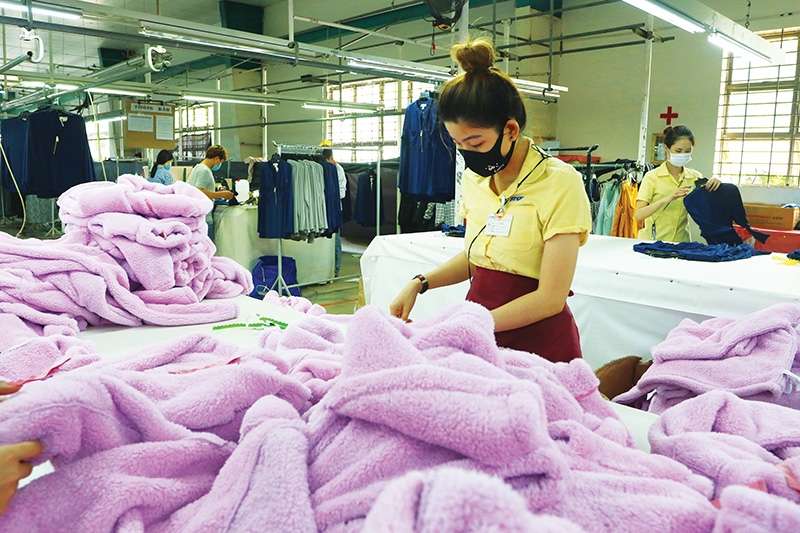Garment and footwear await EU orders with bated breath
 |
| Orders for the textile, leather, and footwear producers have been dropping since the outbreak of the pandemic, photo Le Toan |
Now that the EU-Vietnam Free Trade Agreement (EVFTA) came into force in the beginning of August, exports are expected to gradually improve as the deal offers a lot of chances for businesses that manage to adjust to its terms and conditions.
Phan Thi Thanh Xuan, vice president of the Leather, Footwear and Handbag Association (Lefaso) said, “We expect that the EVFTA will help increase orders, restore markets, and release our inventories. However, businesses still need to be realistic about the current situation as they are short of orders.”
The textile and footwear industries’ run of high growth came to an end in January after the pandemic arrived in Vietnam, leading to a harsh decrease in both garments and footwear, by 21 per cent ($2.6 billion) and 9.7 per cent ($1.6 billion), respectively, compared with the previous month, according to the General Statistics Office.
“Orders decreased from the first quarter when the supply of raw materials slowly broke. It plummeted during the second and more seriously in the third quarter. Meanwhile, the order sheets for the fourth quarter this year are blank,” said Pham Xuan Hong, chairman of the Textile and Embroidery Association.
The heavy impact the two industries took from the pandemic was also reported by the Ministry of Industry and Trade (MoIT). According to its six-month report, the textile sector lost around 50 per cent of its orders, especially in May and June, which led to a price drop of about 20 per cent.
According to the General Department of Customs, the export of textile, leather, and footwear materials in July only reached around $925 million, down 18.7 per cent on-year. Exports to the EU also fell sharply, affecting popular markets like Italy, the Netherlands, France, Spain, and Sweden, which negatively impacted Vietnam’s strong commodities, such as jackets and sports shoes.
Than Duc Viet, general director at Garment 10 Corporation, told VIR that his company “has not received enough orders for September.”
Compared to domestic orders, export orders only accounted for 30 per cent of Garment 10’s sales this year. Viet added, “The prospects of rebounding to pre-pandemic levels are bleak.”
Meanwhile, some other businesses still managed to get orders from European buyers. However, due to the difficulties in acquiring the necessary materials and the largely closed borders of the EU, they also meet hurdles along the way.
“The price of imported raw materials from the EU has increased dramatically as these goods are being transported by air. The pandemic continues to prevent traffic. Sometimes there’s only one flight a week from Germany, France, and Italy to Vietnam,” said Nguyen Huu Thanh, director of fashion company Eurolink.
The EU is the second-most important export market for the leather and footwear industry, accounting for nearly 30 per cent of the country’s export turnover with about $6 billion in value annually. Meanwhile, the bloc represents the largest consumption market for Vietnam’s textiles and garments with a volume of over $250 billion a year. Amid difficulties, the leather and footwear industry has has reduced its export target by over 10 per cent from the initially expected $24 billion.
According to Tran Thanh Hai, deputy director of the MoIT’s Import and Export Department, the EVFTA will support the industry with its tariff cuts, but may not be the deciding factor. He explained that even though 42 per cent of tariff lines for the textile and garment sector are now cut to zero, only half of them applies to Vietnam’s strongest commodities. Additionally, the immediate tariff cuts only apply to 1.8 per cent of the export turnover to the EU.
Expectations to benefit from the EVFTA are overwhelming changes in European consumer behaviour, while the European Commission forecast its economy to decline by 8.7 per cent this year.
According to Denis Gouttenoire, senior consultant of the Swiss Import Promotion Programme (SIPPO), the European market currently shows two dominant development trends, with one being the same as before the pandemic and the other more cautious. During an online conference at the end of May, Gouttenoire said that, “Some people buy more jubilantly after the break, but the majority follows a conservative consumption pattern.”
Gouttenoire added, “65 per cent of EU traders don’t buy as much as before. Meanwhile, many of them remain unsure about what consumers end up buying, suggesting that overall consumption may drop a lot, even well into 2021. Additionally, many buyers might adjust their purchasing policies, looking for suppliers who also reflect environmental and social responsibility values.”
| With the EVFTA already in effect, the tariffs for Vietnamese textiles and garments will be reduced to zero, following four models: A – tariffs will be entirely eliminated; B3 – tariffs will be reduced to 3 per cent within four years; B5 – a decrease to 2 per cent within six years; and B7 – a reduction to 1.5 per cent after eight years. Additionally, 37 per cent of Vietnam’s leather and footwear tariff lines will be cut to zero, focusing on sport shoes, canvas shoes, and rain boots. The rest will gradually be decreased from 12.5 per cent to zero according to a schedule that depends on each item. |
Apart from social distancing measures taken by many countries, the pandemic also influenced consumer behaviours in that it made them more careful before spending money, especially in the luxury segment. A survey by Deloitte conducted in 13 countries with over 1,000 participants each showed that consumers’ financial concerns are “relatively high”. On average, 42 per cent of respondents fear to lose their job, with 62 per cent of Spanish respondents agreeing with this statement. Spanish respondents also showed increased concerns over the implementation of upcoming payments. Meanwhile, people answering Deloitte’s questionnaire in the United Kingdom, Spain, and Italy reported more financial insecurities than those in other countries.
The European fashion industry continues to experience financial difficulties, with some even registering for bankruptcy.
Gouttenoire from SIPPO believes that European buyers expect flexibility, adaptability, and transparency from Vietnamese suppliers whenever the pandemic is over, which also means they should be more innovative and faster in delivering while still fulfilling all requirements of even the smallest orders.
| Phan Van Chinh - Director general, Agency of Foreign Trade, Ministry of Industry and Trade
As a new-generation agreement, the EVFTA is expected to have multifaceted impacts on the Vietnamese economy, helping to bolster trade with the EU on all fronts. The deal’s official enforcement widens the doors for “Made in Vietnam” goods to enter the EU common market; pushes up investment attraction and local production, particularly in supporting industries; and creates more jobs and improve labour efficiency, among others. On the trade front, the EU is one of Vietnam’s largest export markets, just behind the United States, with textile and garment, and footwear being Vietnam’s key export items. These sectors are now entitled to nearly 90 per cent tariff reductions, with many tariff lines totally removed. Tariff preferences and the conditions on opening the market will help enhance the competitiveness of local products. Although several countries exporting textile, clothing, and footwear products to the EU are currently favoured with several kinds of preferences, with the EVFTA, Vietnam now has eminent advantages. For instance, textiles and garments made in Vietnam have competitive advantages over Chinese-made products and can compete on an equal footing in price with export countries who are currently favoured with zero per cent tariffs like Cambodia and Bangladesh – and win with our workers’ high skills and the consistent quality of our products. In Asia, the EU has only inked cooperation agreements with South Korea and Singapore, and neither has similar production structure to Vietnam. The EVFTA, therefore, would create stable advantages for Vietnamese exports. As the second nation in ASEAN having an FTA with the EU, local businesses might seize the opportunity to penetrate the market and start working on the branding of Vietnamese products in this market. Approaching the EU market could also be a stepping stone for “Made in Vietnam” products to break into the markets of other developed economies. In its role, the Agency of Foreign Trade will provide instructions and advocate local companies and business associations to capitalise on the deal, propelling the exports of textiles and garments, and footwear to the EU. |
What the stars mean:
★ Poor ★ ★ Promising ★★★ Good ★★★★ Very good ★★★★★ Exceptional
Themes: EVFTA & EVIPA
Related Contents
Latest News
More News
- PM orders investment model for North–South high-speed rail (December 22, 2025 | 17:43)
- First members of Danang International Finance Centre revealed (December 22, 2025 | 17:39)
- Securing capital and efficiency for Vietnam’s 2026-2030 growth ambitions (December 17, 2025 | 10:00)
- Driving double-digit growth through green and circular transformation in Vietnam (December 17, 2025 | 09:00)
- Vietnam bucking trend in the global M&A landscape (December 16, 2025 | 14:20)
- Vietnam’s green transition demands collective financial action (December 15, 2025 | 12:00)
- VIR workshop highlights capital and policy for sustainable development (December 15, 2025 | 11:00)
- National Assembly approves pilot mechanisms to accelerate major projects in Hanoi (December 12, 2025 | 11:29)
- Vietnam eases policy approval requirements, simplifies foreign and outbound investments (December 11, 2025 | 17:53)
- Unpacking new momentum in Vietnam’s M&A market (December 10, 2025 | 09:59)


 Tag:
Tag:





















 Mobile Version
Mobile Version